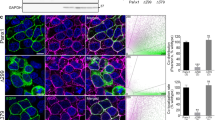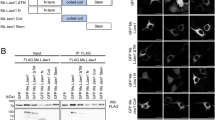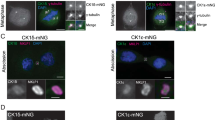Abstract
MAGI-1 and CASK are membrane-associated guanylate kinases of epithelial junctions. MAGI-1 is localized at tight junctions in polarized epithelial cells, whereas CASK is localized along the lateral membranes. We obtained the KIAA0769 gene product through the yeast two-hybrid screening using MAGI-1 as a bait and named it Carom. Carom has a coiled-coil domain in the middle region, and two src homology 3 domains and a PSD-95/Dlg-A/ZO-1 (PDZ)-binding motif in the C-terminal region. Carom binds to the fifth PDZ domain of MAGI-1 and the calmodulin kinase domain of CASK in vitro. MAGI-1 and CASK bind to the distinct sequences in the C-terminal region of Carom, but still compete with each other for Carom binding. The study using a stable transformant of Madine Darby canine kidney (MDCK) cells expressing GFP-Carom revealed that Carom was partially overlapped by MAGI-1 in MDCK cells, which have not yet established mature cell junctions, but became separated from MAGI-1 and colocalized with CASK in polarized cells. Carom was highly resistant to Triton X-100 extractions and recruited CASK to the Triton X-100-insoluble structures. Carom is a binding partner of CASK, which interacts with CASK in polarized epithelial cells and may link it to the cytoskeleton.
This is a preview of subscription content, access via your institution
Access options
Subscribe to this journal
Receive 50 print issues and online access
$259.00 per year
only $5.18 per issue
Buy this article
- Purchase on Springer Link
- Instant access to full article PDF
Prices may be subject to local taxes which are calculated during checkout








Similar content being viewed by others
References
Anderson JM, Stevenson BR, Jesaitis LA, Goodenough DA and Mooseker MS . (1988). J. Cell. Biol., 106, 1141–1149.
Bierderer T and Sudhof TC . (2001). J. Biol. Chem., 276, 47869–47876.
Butz S, Okamoto M and Sudhof TC . (1998). Cell, 94, 773–782.
Christensen EI and Birn H . (2002). Mol. Cell. Biol., 3, 258–268.
Cohen AR, Woods DF, Marfatia SM, Walther Z, Chisti AH, Anderson JM and Wood DF . (1998). J. Cell. Biol., 142, 129–138.
Dimitratos SD, Woods DF and Bryant PJ . (1997). Mech. Dev., 63, 127–130.
Dobrosotskaya I, Guy RK and James GL . (1997). J. Biol. Chem., 272, 31589–31597.
Dobrosotskaya IY . (2001). Biochem. Biophys. Res. Commun., 283, 969–975.
Dobrosotskaya IY and James GL . (2000). Biochem. Biophys. Res. Commun., 270, 903–909.
Fallon L, Moreau F, Croft BJ, Labib N, Gu W-J and Fon EA . (2002). J. Biol. Chem., 277, 486–491.
Fanning AS and Anderson JM . (1999). Curr. Opin. Cell. Biol., 11, 432–439.
Hata Y, Butz S and Sudhof TC . (1996). J. Neurosci., 16, 2488–2494.
Hirabayashi S, Tajima M, Yao I, Nishimura W, Mori H and Hata Y . (2003). Mol. Cell. Biol., 23, 4267–4282.
Hirao K, Hata Y, Ide N, Takeuchi M, Irie M, Yao I, Deguchi M, Toyoda A, Sudhof TC and Takai Y . (1998). J. Biol. Chem., 273, 21105–21110.
Hoskins R, Hajnal AF, Harp SA and Kim SK . (1996). Development, 122, 97–111.
Hsueh YP, Wang TF, Yang FC and Sheng M . (2000). Nature, 404, 298–302.
Hsueh YP, Yang C, Kharazia V, Naisbitt S, Cohen AR, Weinberg RJ and Sheng M . (1998). J. Cell. Biol., 142, 139–151.
Ide N, Hata Y, Nishioka H, Hirao K, Yao I, Deguchi M, Mizoguchi A, Nishimori H, Tokino T, Nakamura Y and Takai Y . (1999). Oncogene, 18, 7810–7815.
Irie M, Hata Y, Deguchi M, Ide N, Hirao K, Yao I, Nishioka H and Takai Y . (1999). Oncogene, 18, 2811–2817.
Lee S, Fan S, Makarova O, Straight S and Margolis B . (2002). Mol. Cell. Biol., 22, 1778–1791.
Lue RA, Marfatia SM, Branton D and Chisti AH . (1994). Proc. Natl. Acad. Sci. USA, 91, 9818–9822.
Marinez-Estrada OM, Villa A, Breviario F, Orsenigo F, Dejana E and Bazzoni G . (2001). J. Biol. Chem., 276, 9291–9296.
Maximov A and Bezprozvanny I . (2002). J. Neurosci., 22, 6939–6952.
Mayer BJ . (2001). J. Cell Sci., 114, 1253–1263.
Mino A, Ohtsuka T, Inoue E and Takai Y . (2000). Genes Cells, 5, 1009–1016.
Muller BM, Kistner U, Veh RW, Cases-Langhoff C, Becker B, Gundelfinger ED and Garner CC . (1995). J. Neurosci., 15, 2354–2366.
Nishimura W, Iizuka T, Hirabayashi S, Tanaka N and Hata Y . (2000). J. Cell Physiol., 185, 358–365.
Ohno H, Hirabayashi S, Iizuka T, Ohnishi H, Fujita T and Hata Y . (2002). Oncogene, 21, 7042–7049.
Olsen O, Liu H, Wade JB, Merot J and Welling PA . (2002). Am. J. Physiol Cell Physiol., 282, C183–C195.
Patrie KM, Drescher AJ, Goyal M, Wiggins RC and Margolis B . (2001). J. Am. Soc. Nephrol., 12, 667–677.
Patrie KM, Drescher AJ, Welihinda A, Mundel P and Margolis B . (2002). J. Biol. Chem., 277, 30183–30190.
Setou M, Nakagawa T, Seog D-H and Hirokawa N . (2000). Science, 288, 1796–1802.
Shiratsuchi T, Futamura M, Oda K, Nishimori H, Nakamura Y and Tokino T . (1998). Biochem. Biophys. Res. Commun., 247, 597–604.
Stevenson BR, Siliciano JD, Mooseker MS and Goodenough DA . (1986). J. Cell Biol., 103, 755–766.
Tabuchi K, Biederer T, Butz S and Sudhof TC . (2002). J. Neurosci., 22, 4264–4273.
Acknowledgements
We thank Dr Gary Nolan (Stanford University) for phoenix ampho cells and Dr Yusuke Nakamura (University of Tokyo) for cDNA of human MAGI-1. We also thank Ms C Rokukawa and Ms M Miyahara-Tenkatsu for skillful technical assistance. GST-CASK-Camk was generated by YH in Dr Thomas C Sudhof's laboratory (University of Texas).
This study was supported by grants-in-aids for Scientific Research (B) and on Priority Areas, and Special Coordination Funds for Promoting Science and Technology from the Ministry of Education, Culture, Sports, Science, and Technology, and a grant from Yamanouchi Foundation for Research on Metabolic Disorders (2000).
Author information
Authors and Affiliations
Corresponding author
Rights and permissions
About this article
Cite this article
Ohno, H., Hirabayashi, S., Kansaku, A. et al. Carom: a novel membrane-associated guanylate kinase-interacting protein with two SH3 domains. Oncogene 22, 8422–8431 (2003). https://doi.org/10.1038/sj.onc.1206996
Received:
Revised:
Accepted:
Published:
Issue Date:
DOI: https://doi.org/10.1038/sj.onc.1206996
Keywords
This article is cited by
-
F-BAR family proteins, emerging regulators for cell membrane dynamic changes—from structure to human diseases
Journal of Hematology & Oncology (2015)
-
High expression of FCHSD2 is associated with chemoresistance in adult acute myeloid leukemia
Comparative Clinical Pathology (2014)
-
Increased tumorigenesis associated with loss of the tumor suppressor gene Cadm1
Molecular Cancer (2012)
-
MAGI-1 is a component of the glomerular slit diaphragm that is tightly associated with nephrin
Laboratory Investigation (2005)



